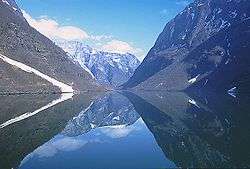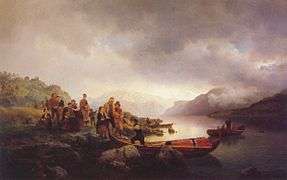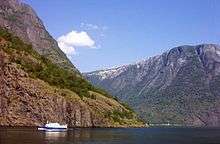Sognefjord
| Sognefjorden | |
|---|---|
| Sognefjord | |
 View of the fjord | |
 | |
| Location | Sogn og Fjordane county, Norway |
| Coordinates | 61°06′N 5°10′E / 61.100°N 5.167°ECoordinates: 61°06′N 5°10′E / 61.100°N 5.167°E |
| Basin countries | Norway |
| Max. length | 205 kilometres (127 mi) |
| Max. width | 4.5 kilometres (2.8 mi) |
| Max. depth | 1,308 metres (4,291 ft) |
The Sognefjord or Sognefjorden is the largest and best known fjord in Norway and the second longest in the world. Located in Sogn og Fjordane county in Western Norway, it stretches 205 kilometres (127 mi) inland from the ocean to the small village of Skjolden in the municipality of Luster. The fjord takes its name from the traditional district of Sogn, which covers the southern part of the county.[1]
Geography

The fjord runs through many municipalities: Solund, Gulen, Hyllestad, Høyanger, Vik, Balestrand, Leikanger, Sogndal, Lærdal, Aurland, Årdal, and Luster. The fjord reaches a maximum depth of 1,308 metres (4,291 ft) below sea level, and the greatest depths are found in the central parts of the fjord near Høyanger.[2][3] Sognefjord is more than 1,000 metres (3,300 ft) deep for about 100 km of its length, from Rutledal og Leikanger. Near its mouth, the bottom rises abruptly to a sill about 100 metres (330 ft) below sea level. The seabed in Sognefjord is covered by some 200 metres (660 ft) thick sediments such that the bedrock is some 1,500 metres (4,900 ft) below sea level. The fjord is up to 6 km wide.[4] The average width of the main branch of the Sognefjord is about 4.5 kilometres (2.8 mi). Cliffs surrounding the fjord rise almost sheer from the water to heights of 1,000 metres (3,300 ft) and more.
The inner end of the Sognefjord is localized southeast of a mountain range rising to about 2,000 metres (6,600 ft) above sea level and covered by the Jostedalsbreen, continental Europe's largest glacier. Thus the climate of the inner end of Sognefjorden and its branches are not as wet as on the outer coastline. Hurrungane range at the eastern end of the fjord reaches 2400 m. The greatest elevation from sea bed to summit is at Sogndal. Several rivers pour fresh water into the fjord with an annual "spring" flood in June.[5] The mouth of the fjord is surrounded by many islands including Sula, Losna, and Hiserøyna.
The volume of Sognefjorden with branches is about 500 km3, while the total volume of rock eroded by glaciers from the entire Sognefjord system and adjacent valleys is about 4000 km3.[4]
Branches
There are many smaller fjords which branch off the main fjord.
- Sognesjøen (mouth) (35 km)
- Lifjorden (6 km)
- Høyangsfjord (8 km)
- Arnafjord (8 km)
- Esefjord (4 km)
- Fjærlandsfjord (27 km)
- Sogndalsfjord (21 km)
- Aurlandsfjord (29 km)
- Nærøyfjord (a World Heritage Site)
- Lærdalsfjord (9 km)
- Årdalsfjord (16 km)
- Lustrafjord (innermost) (42 km)
Lustrafjordn
The innermost arm of the Sognefjorden is called the Lustrafjord, located in the municipality of Luster. At its end, there is the village of Skjolden, which is an access point to Jotunheimen National Park. In earlier times, transport between Bergen and the Scandinavian inland was by boat between Bergen and Skjolden and from there on a simple road over the highlands (today Norwegian County Road 55), or by boat to Lærdal and through the mountain pass to Valdres (now European route E16).
Tourism

Boats connect settlements along the fjord and its sidearms. Larger villages on the fjord and its branches include Leirvik, Ytre Oppedal, Vadheim, Høyanger, Vikøyri, Balestrand, Hermansverk, Sogndalsfjøra, Gudvangen, Flåm, Aurlandsvangen, Lærdalsøyri, Årdalstangen, Gaupne, and Solvorn. Gudvangen is situated by the Nærøyfjord, a branch of the Sognefjord particularly noted for its unspoiled nature and dramatic scenery, and only 300 metres (980 ft) across at its narrowest point. The Nærøyfjord is a UNESCO World Heritage Site. From the village of Flåm, the Flåm Railway climbs 864 metres (2,835 ft) up to Myrdal Station in a distance of only 20 kilometres (12 mi)—the steepest unassisted railway climb in the world.[6]
Around the inner end of the fjord, three of Norway's famous stave churches have survived: Kaupanger and Urnes (along the shoreline) and Borgund (30 kilometres or 19 miles into the Lærdal valley).[6]
The Sognefjord Span (power lines) crosses the fjord with a span of 4,597 metres (15,082 ft). This is the second largest span of power lines in the world. The fjord has become a tourist attraction with summer tourists being an important part of the local economy.
Other
- On 24 November 1972, the submarine KNM Sklinna of the Royal Norwegian Navy had "contact" with what they presumed was a Whiskey-class submarine, after 14 days of "hunt" in the Sognefjorden. Newly released military documents confirms this episode.[7]
See also
References
- ↑ Store norske leksikon. "Sognefjorden" (in Norwegian). Retrieved 2010-09-04.
- ↑ Øi, Ørnulf (1987). Norges sjøatlas : fra svenskegrensen til Sognefjorden. Oslo: Nautisk forlag i samarbeid med Statens kartverk, Norges sjøkartverk. pp. 225, 244. ISBN 8290335024.
- ↑ Store norske leksikon. "Sognefjorden" (in Norwegian). Retrieved 2010-09-04.
- 1 2 Andersen, Bjørn G. (2000). Istider i Norge. Landskap formet av istidenes breer. Oslo: Universitetsforlaget. p. 30. ISBN 9788200451341.
- ↑ "Sognefjorden – Store norske leksikon". Store norske leksikon. Retrieved 2016-11-22.
- 1 2 "Sognefjord". Retrieved 2010-09-04.
- ↑ Aftenposten(Norwegian Language) (including pictures)
External links
| Wikimedia Commons has media related to Sognefjorden. |
| Wikivoyage has a travel guide for Sognefjorden. |
- www.sognefjord.no
- Flåmsbana information
- Art of the States: Bright Days of Little Sunlight musical work inspired by the Sognefjord
